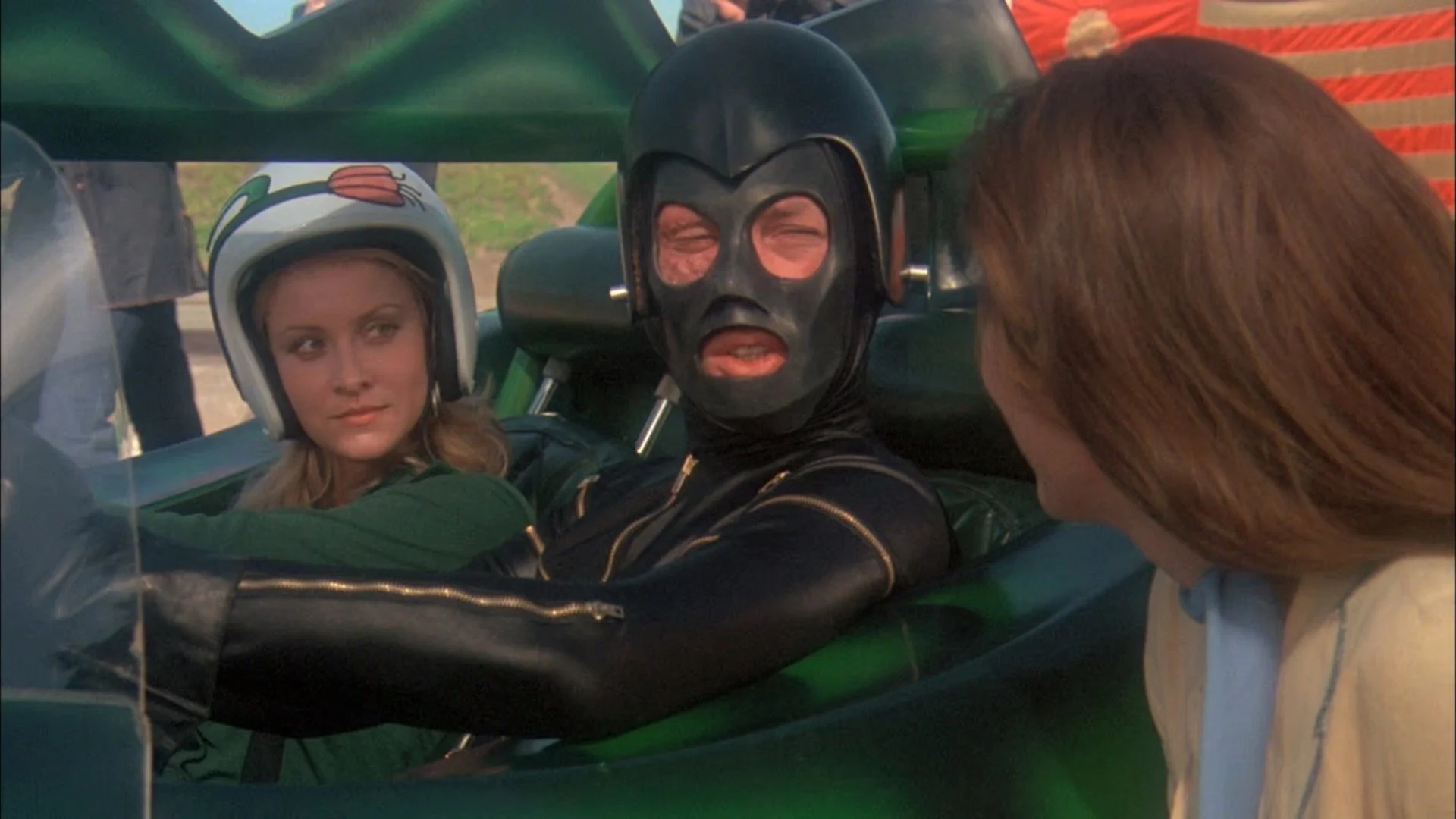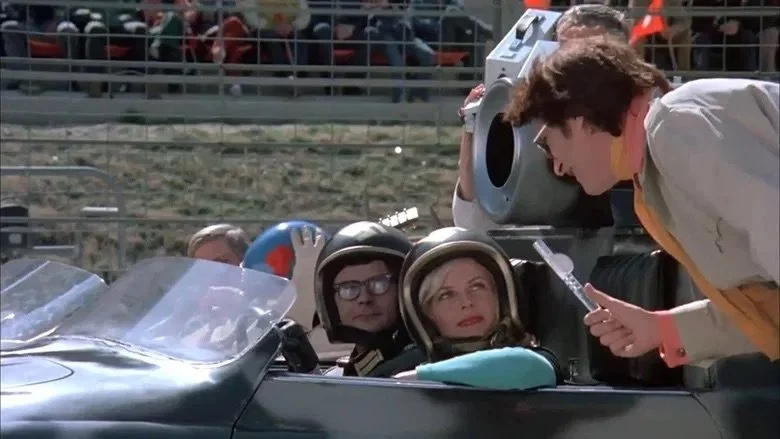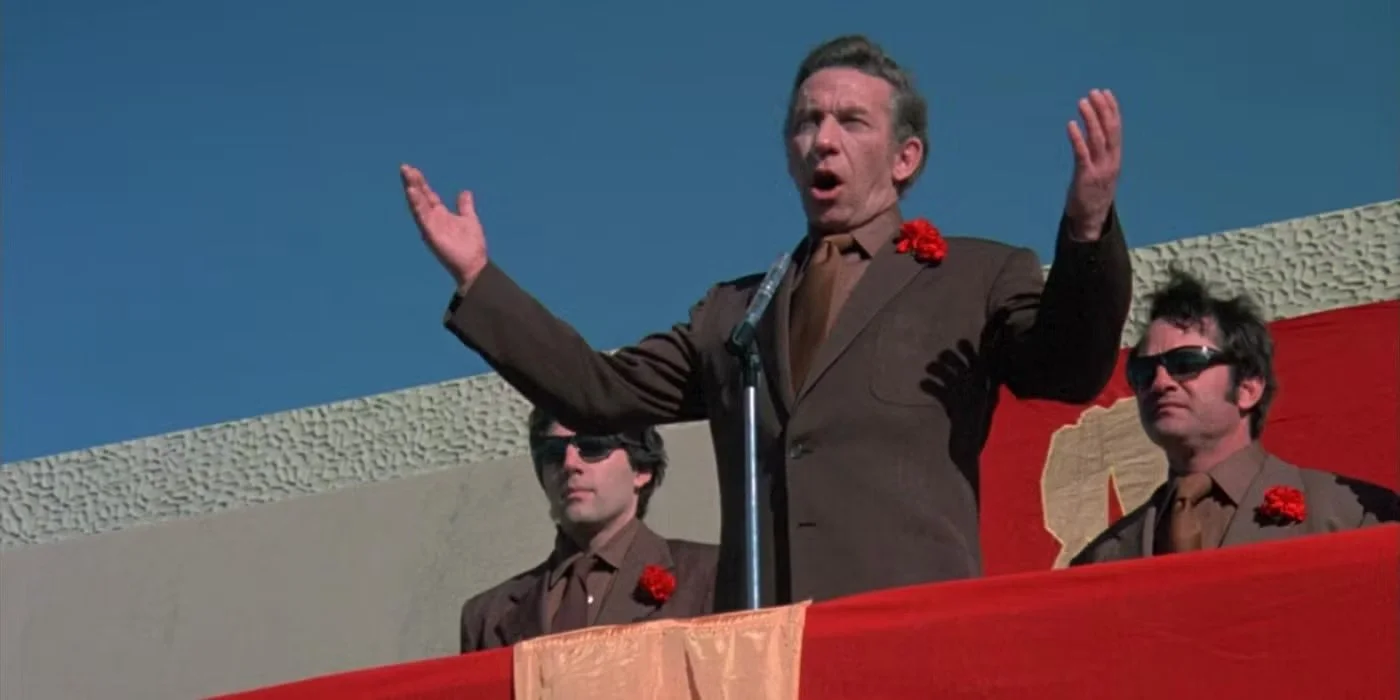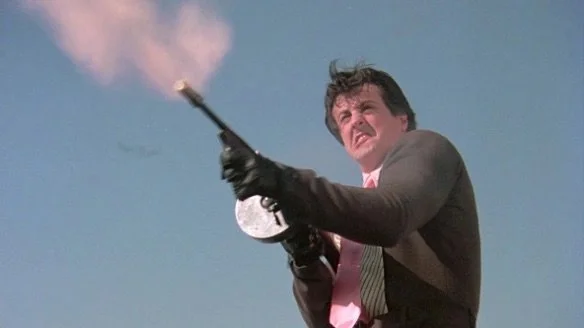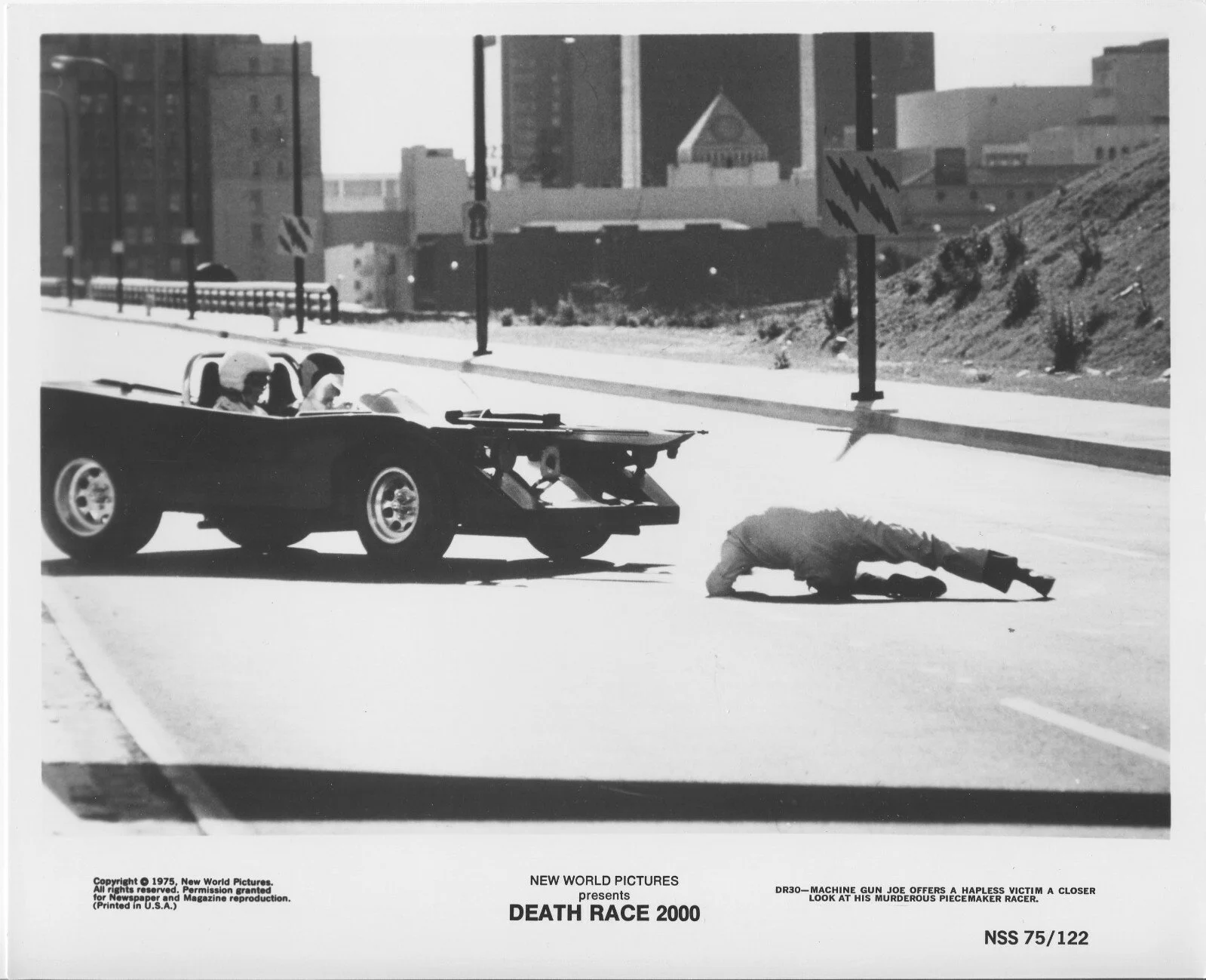Hit and Run...and Score: Death Race 2000 (1975)
Cinematic Semicentennial Series – 1975 edition
Original poster art
Strap in as our Cinematic Semicentennial Series kicks into high gear with a glimpse of a future where a particular gladiatorial sport is all the (road) rage.
In the Year 2000
It is the year 2000 and the “U.S. Provinces of America” (U.S.P.A.) has been a dystopian nation ever since the World Crash of ‘79 broke its economy, paving the way for totalitarianism. Its authoritarian cult-like leader “Mr. President” rules despotically and often from afar in palaces in China and Russia. To entertain and (more importantly) distract the populace, Mr. President hosts the Annual Transcontinental Road Race whereby a select group of competitors in tripped-out cars speed across the U.S.P.A. from New York to Los Angeles.
But there is a major wrinkle to this race—drivers are awarded points for running down civilians they encounter along their respective routes. And how might you ask do they tally said points? Well, there is a very simple scoring system: women are worth 10 points, teenagers 40 points (that feels a little low, no?), kids under 12 years 70 points, and anyone older than 75 years of age is worth 100 points. Better get out those calculators!
Start Your Engines
Our race announcer is reporter Junior Bruce (Don Steele), who broadcasts updates with a manic energy and a near-constant ear-to-ear smile. Bruce sets the stage by introducing the competitors with real gusto. We should preface these introductions by explaining that each car includes both a driver and navigator; the former is charged with putting the pedal to the metal to dispatch pedestrians, while the latter charts a course, anticipates threats, identifies viable targets, and makes themselves sexually “available” to their respective drivers.
So, without further ado let’s meet our racers, all of whom play themed characters reminiscent of those in the professional wrestling world. We have “Nero the Hero” (Martin Kove), loosely inspired by the none too popular first Roman Emperor. Nero is a vain and attention-seeking driver with a seemingly bored navigator (Cleopatra) who seems to relish sassing him. Their car resembles an animal of some kind—a lion perhaps? Hard to tell, but that’s besides the point.
Next is “Calamity Jane” Kelly (Mary Woronov) and her navigator “Pete.” Jane is adorned in a western cowgirl-inspired outfit and drives a car that resembles a bull, replete with horns that she sometimes uses to impale her targets. In case you were wondering: no extra points for impalements. Jane is a skilled and empowered driver who doesn’t take any guff but also has a sweet side (if you can believe it).
Then there is “Matilda the Hun,” (Roberta Collins), an actual Nazi with blond hair and a firm belief in a master race. She and her nerdy navigator “Herman the German” Bloch sport swastikas and ride in a black-and-gray camouflaged car accessorized with a single point in front and something resembling a cannon on top. Her adoring fans, thankfully in the minority, can be seen zealously waving Nazi flags at the start of the race. Yikes.
Junior Bruce introduces our racers
Now we come to “Machine Gun” Joe Viterbo (Sylvester Stallone), a 1930s gangster-themed character with a bombastic and irascible persona. His all-black car is fitted with a giant blade in front, along with a pair of decorative and theme-appropriate tommy guns. Joe is a very strong competitor who has come the closest to beating Frankenstein in previous races, no doubt helping to grow that sizeable chip on his shoulder. Joe’s navigator is the buxom Myra (Louisa Moritz), who is often on the receiving end of Joe’s tirades.
And yes, you heard that right: our fifth and final racer is two-time champion Frankenstein (David Carradine). He acquired this moniker from the many body parts he’s had replaced due to crashes suffered in his years of competitive racing. His various surgical reconstructions, conducted by government scientists, have made him an even stronger driver. Frankenstein’s car is reptilian themed with long, sharp teeth and scales that run the length of the vehicle. To further accentuate his dominance, he wears an almost kinky black leather mask and body suit that hide his scarred face and body.
Mr. President signals the start of the race from his summer palace in Beijing with the press of a button. The competitors peel out out of New York City via the Lincoln Tunnel and are soon out on the open road (strange how much New Jersey resembles southern California). The cars take different routes west and it is not long before the homicidal hijinks ensue, as our competitors chase, crush, side swipe, and impale pedestrians while racking up points. Not wanting to be left out of the fun, some thrill-seeking individuals engage in games of chicken with the drivers, with one going so far as to play the part of matador by challenging Calamity Jane to a bull fight.
Bull fight with Calamity Jane
A Cog in the Wheel
Complicating the race is “The Resistance,” a group of rebels determined to sabotage the barbaric race and kidnap its most popular driver Frankenstein, who also happens to be Mr. President’s close friend. The leader of the Resistance is one “Thomasina Paine” (Harriet Medin), a sage older woman who decries the violence of the Transcontinental Race and the regime of the authoritarian Mr. President. She is also a descendant of American Revolutionary Thomas Paine. Her granddaughter Annie (Simone Griffith) is operating undercover as Frankenstein’s new navigator, hoping to win her driver’s trust and help facilitate his kidnapping. If the kidnapping is successful, Thomasina will demand that the race be abolished. Meanwhile The Resistance initiates a series of pirated underground TV broadcasts to speak out against the government.
While Thomasina is largely against violent resistance, others in the movement have no such qualms. This leads to several sequences where resistance operatives target the racers through direct attacks and trickery, leading to sequences straight out of those Wile E. Coyote and Roadrunner cartoons as saboteurs employ phony signs, planted bombs, and various other ruses. Unlike Wile E. Coyote, who often had his efforts thwarted by the elusive roadrunner, the Resistance manages to score a few wins.
Meanwhile Mr. President takes to the airwaves to blame the sabotage on the “Evil French.” In fact, he blames absolutely everything on the French, including ruining the economy and telephone system; it would seem that scapegoating and impugning the French goes back a way. And here we thought “Freedom Fries” was as silly as it gets . . .
The film’s final third features some action-packed racing sequences, comical kills, fist fights, explosions, frenetic Benny Hill-style hijinks, twists and hairpin turns, and hidden agendas revealed in dramatic fashion. It’s a wild ride (pun absolutely intended)!
U.S. and International lobby cards
My two cents
Death Race 2000 is a sci-fi/comedy that rarely pumps the brakes on its satirical and slapstick humor during its sub-90-minute run time. The production has a chintzy and cheesy feel in keeping with its slim budget and exploitation sensibilities that are very much in the Roger Corman vein. For the uninitiated, Roger Corman is a legend of b-movie cinema who produced and/or directed hundreds of profitable low-budget films over a career that spanned the second half of the 20th century and into the 21st. Death Race 2000 features several trademarks of 1970s/1980s Corman productions, serving up generous helpings of cheeky comedy, gratuitous nudity, hyper unrealistic action sequences, scenes of bloody—yet cartoonish—violence, a smattering of sleaze, and flouting of what polite society might deem good taste. But do we love it? Yes, we do!
Director Paul Bartel infuses the film with lots of madcap energy and campy humor. The native Brooklynite has said that black comedy is his favorite genre and that certainly comes across in Death Race 2000. Bartel, also an actor, exudes a wry and irreverent sensibility in front of and behind the camera. If I had to pick another film to showcase Bartel’s artistic sensibilities it would be the cult classic Eating Raoul (1982), a film he directed and starred in alongside Mary Woronov. The two play a couple who lure unsuspecting swingers into their apartment only to knock off, rob, and “repurpose” them as meat for their new restaurant. Bartel, who somehow makes cannibalism great fun, would go on to appear in many other Corman productions in sizable roles and cameos. No matter his part in a film, Bartel rarely fails to illicit a smile or chuckle, at least from this monster kid. He passed away on May 13, 2000 (kind of an odd coincidence, don’t you think?).
Black & White publicity stills
The cast of Death Race 2000 is made up of many character actors representing a mixed bag when it comes to experience. That said, most of the cast was clearly game to embrace the spirit of such an absurd and screwball film. It was amusing to watch a very young pre-Rocky Sylvester Stallone as “Machine Gun” Joe Viterbo, the hot-headed racer looking to win one in “the name of hate.” David Carradine gives a typically chill performance as the mysterious racing champion Frankenstein, while Joyce Jameson hams it up big time as the Marilyn Monroe-like “Grace Pander,” who provides color commentary and interviews where she introduces nearly everyone as a “dear friend of mine.” If this movie was remade today I could very much see Grace being played by Jennifer Coolidge. Simone Griffith is a bit flat as Annie, which is a shame considering that she is a key player as Frankenstein’s navigator, potential love interest, and covert operative for the rebellion.
Mary Woronov is charismatic as Calamity Jane, the daring, spunky racer with a good heart. The tall, deep-voiced Woronov cut quite the cult figure in the 1970s and 1980s having spent time in Andy Warhol’s NYC Studio “The Factory.” She acted in several Warhol films and appeared in many Roger Corman productions, which only served to heighten her cult status.
The production design has a bit of a cheap—almost flimsy—feel to it. The opening of the race inside a stadium features a matte painting of a futuristic city in the background that is comically unconvincing. That said, I enjoy both good and bad mattes, so I have no real complaints on that front. Scenes with interior shots stand out for their sparseness; while this might suggest the minimalist aesthetic of the future, at times it simply feels like the production team didn’t have the time and/or money to properly dress the sets. The cars, on the other hand, are indisputably juvenile and cheesy—but they are such a guilty (or not) pleasure.
While the racing sequences are frequent and exciting enough, it is safe to say that none of these scenes reach the artistic heights of films such as Bullitt (1968), The French Connection (1971), or Mad Max: Fury Road (2015). The kills run the gamut, from brutal and bloody, to cartoonish, farcical, and bloodless, but they are virtually all played for laughs. Death Race 2000 is a very entertaining movie, though I concede that its b-movie/exploitation roots and outlandishness is not for everyone. In the end, the film succeeds in large part thanks to a producer and creative team that smartly leaned into the absurdist elements and made a conscious decision not to take the material (or themselves) too seriously.
Original trailer for Death Race 2000
Death Race 2000 at 50
Death Race 2000 hit U.S. theaters in the spring of 1975. I could not get exact numbers but from what I can tell the budget for the film was somewhere around $300,000 to $500,000 and it made somewhere between $5 million - $8 million at the box office. Like most Roger Corman-produced films, a slim and shrewdly allocated budget ensured that the film made money. Considering its b-movie allure and short run time, I must imagine the film was screened at many a drive-in across the U.S. in the latter 1970s and into the 1980s.
We lost Roger Corman, “King of the Bs,” just a tad over a year ago on May 9, 2024 at the age 98. His is a fascinating career spent serving up low-budget yet profitable genre films and exploitation cinema while also helping along early careers of many actors and directors including but not limited to Ron Howard, Jack Nicholson, Martin Scorsese, Gale Anne Hurd, James Cameron, John Sayles, Pam Grier, Peter Bogdanovich, Joe Dante, and ubiquitous character actor Dick Miller.
Over the course of his long career he made black and white science fiction and monster movies, a series of impressive Edgar Allan Poe adaptations starring Vincent Price, crime movies, action films, slashers, sci-fi thrillers, and not-so-subtle exploitation fair. We could go on and on about Corman but should probably wrap up this portion with a recommendation. Check out the 2011 documentary Corman’s World: Exploits of Hollywood Rebel, a light and breezy film with great insights into Corman’s unique and independent approach to filmmaking. It also includes interviews with various creatives whose careers and lives were touched by Corman. In it, he discusses how the release of Star Wars in 1977 ushered in the era of big-budgeted sci-fi and high adventure cinematic spectacles that would ultimately marginalize small films that simply couldn’t compete against the large studios.
Death Race 2000 has a true legacy for being one of those emblematic cult films of the 1970s that is still referenced today. The premise of a future totalitarian government that distracts its oppressed citizenry with a gladiatorial-style game of life and death has been employed many times over in literature and film. Examples include Rollerball (1975), The Running Man (1987), The Hunger Games films (2012-2023), and Battle Royale (2000).
Note: There were five Death Race 2000 sequels/reboots between 2008 and 2018, but I must admit I haven’t seen any of them.
Cast (abridged)
David Carradine – Frankenstein
Sylvester Stallone – “Machine Gun” Joe Viterbo
Louisa Moritz – Myra
Simone Griffeth – Annie
Mary Woronov – Calamity Jane
Roberta Collins – Matilda the Hun
Martin Kove – Nero the Hero
Don Steele – Junior Bruce
Sandy McCallum – Mr. President
Joyce Jameson – Grace Pander
Crew (abridged)
Director – Paul Bartel
Cinematographer – Tak Fujimoto
Makeup Artist – Patricia Hutchence
Music – Paul Chihara
Producer – Roger Corman
Production Company: New World Pictures
How did I watch?
Streaming on Tubi
Running Time: 1h 24m
MPAA Rating: R
Did you know?
Fans of the Karate Kid films and the recently wrapped series Cobra Kai might recognize Martin Kove as “Nero the Hero.” Kove played the arch villain sensei John Creese in both the Karate Kid films and the recent spin-off series.
Director Paul Bartel contributed to several other Corman productions as actor, writer, and director, including Piranha (1977), where he memorably plays the officious summer camp director Mr. Dumont.
According to the AFI, Death Race 2000 was produced and released quickly to ensure an opening date before Rollerball, which has some similar dystopian themes albeit with a far more somber tone.
Mary Woronov has some legit genre credentials with roles in Silent Night, Bloody Night (1972), Night of the Comet (1984), and House of the Devil (2009), among many others. As a once huge fan of the band Suicidal Tendencies, I was tickled to learn that Woronov appears as the angry and clueless Mom in the video for their song “Institutionalized.”
Devotees of Gremlins (directed by Corman disciple Joe Dante) may recognize Don Steele as the voice of radio DJ Rockin' Ricky Rialto.
Corman received an honorary Oscar in 2009, where he was praised by the likes of Jonathan Demme and Quentin Tarantino.
Recommendations based on Death Race 2000
Roller Ball (1975)
Logan’s Run (1976)
Turkey Shoot (1982)
Battle Royale (2000)
Supplements-
Roger’s Retrospective: Celebrating Corman Classics, Part 1 (Fangoria)
Roger Corman, Pioneering Independent Producer and King of B Movies, Dies at 98 (Variety)
Roger’s Retrospective: 13 Of Corman’s Producing And Distribution Favorites (Fangoria)










